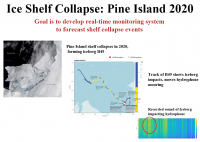Ross and Amundsen Seas
The Southern Ocean plays an essential role in regulating the Earth's climate, however rapid increases in global temperatures are leading to disintegration of Antarctic ice shelves and collapse of ice sheets, which in turn leads to global sea level rise. Most of Antarctica's impact on sea level rise comes from West Antarctica, where the majority of ice loss occurs at the Pine Island and Thwaites glaciers. This ice loss is primarily driven by the increased melting of the ice shelves that buttress glaciers due to warmer ocean waters. The warming is caused by greater movement of warm Circumpolar Deep Water (CDW) reaching the glaciers' deep grounding zones. Thus a better understanding and proper assessment of the Southern Ocean changes are needed to provide the scientific basis for climate change response policies.
With these goals in mind NOAA-PMEL and the Korea Polar Research Institute began the SOUNDS project, which will facilitate idea and dataset exchange to study the Southern Ocean response to increased global temperatures. The goal is to deploy two PMEL moored hydrophones to collect ~8 years of continuous (1 kHz) passive acoustic data within Terra Nova Bay and Amundsen Seas. The objective of our underwater acoustic research is to monitor icequake activity at the Nansen, Drygalski, Dotson and Thwaites ice shelves to quantify the stability of the shelves, and possibly forecast major shelf collapse events.





